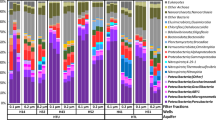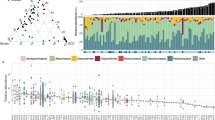Abstract
The deep biosphere is often characterized by multiple extreme physical–chemical conditions, of which pressure is an important parameter that influences life but remains less studied. This geomicrobiology study was designed to understand the response of a subterranean microbial community of the Deccan traps to high-pressure conditions and to elucidate their genomic properties. Groundwater from a deep basaltic aquifer of the Deccan traps was used to ascertain the community response to 25 MPa and 50 MPa pressure following enrichment in high-salt and low-salt organic media. Quantitative PCR data indicated a decrease in bacterial and archaeal cell numbers with increasing pressure. 16S rRNA gene sequencing displayed substantial changes in the microbial community in which Acidovorax appeared to be the most dominant genus in the low-salt medium and Microbacteriaceae emerged as the major family in the high-salt medium under both pressure conditions. Genes present in metagenome-associated genomes which have previously been associated with piezotolerance include those related to nutrient uptake and extracytoplasmic stress (omp, rseC), protein folding and unfolding (dnaK, groEL and others), and DNA repair mechanisms (mutT, uvr and others). We hypothesize that these genes facilitate tolerance to high pressure by certain groups of microbes residing in subsurface Deccan traps.





Similar content being viewed by others
References
Aertsen A, Vanoirbeek K, De Spiegeleer P et al (2004) Heat shock protein-mediated resistance to high hydrostatic pressure in Escherichia coli. Appl Env Microbiol 70:2660–2666
Ash K, Brown T, Watford T et al (2014) A comparison of the Caulobacter NA1000 and K31 genomes reveals extensive genome rearrangements and differences in metabolic potential. Open Biol 4:140128
Aziz RK, Bartels D, Best AA et al (2008) The RAST server: rapid annotations using subsystems technology. BMC Genom 9:75
Bankevich A, Nurk S, Antipov D et al (2012) SPAdes: a new genome assembly algorithm and its applications to single-cell sequencing. J Comput Biol 19:455–477
Bartlett DH (1999) Microbial adaptations to the psychrosphere/piezosphere. J Mol Microbiol Biotechnol 1:93–100
Bates ST, Berg-Lyons D, Caporaso JG et al (2011) Examining the global distribution of dominant archaeal populations in soil. ISME J 5:908–917
Caporaso JG, Kuczynski J, Stombaugh J et al (2010) QIIME allows analysis of high-throughput community sequencing data. Nat Methods 7:335–336
Colwell FS, D’Hondt S (2013) Nature and extent of the deep biosphere. Rev Miner Geochem 75:547–574
Dick GJ, Anantharaman K, Baker BJ et al (2013) The microbiology of deep-sea hydrothermal vent plumes: ecological and biogeographic linkages to seafloor and water column habitats. Front Microbiol 4:124
Ding J, Zhang Y, Wang H et al (2017) Microbial community structure of deep-sea hydrothermal vents on the ultraslow spreading Southwest Indian ridge. Front Microbiol 8:1012
Duncan RA, Pyle DG (1988) Rapid eruption of the Deccan flood basalts at the Cretaceous/Tertiary boundary. Nature 333:841–843
Dutta A, Dutta Gupta S, Gupta A et al (2018) Exploration of deep terrestrial subsurface microbiome in Late Cretaceous Deccan traps and underlying Archean basement, India. Sci Rep 8(1):17459
Grossart H-P, Gust G (2009) Hydrostatic pressure affects physiology and community structure of marine bacteria during settling to 4000 m: an experimental approach. Mar Ecol Prog Ser 390:97–104
Gupta H, Rao NP, Roy S et al (2015) Investigations related to scientific deep drilling to study reservoir-triggered earthquakes at Koyna, India. Int J Earth Sci 104:1511–1522
Gurevich A, Saveliev V, Vyahhi N, Tesler G (2013) QUAST: quality assessment tool for genome assemblies. Bioinformatics 29:1072–1075
Heberle H, Meirelles GV, da Silva FR et al (2015) InteractiVenn: a web-based tool for the analysis of sets through Venn diagrams. BMC Bioinform 16:169. https://doi.org/10.1186/s12859-015-0611-3
Jebbar M, Franzetti B, Girard E, Oger P (2015) Microbial diversity and adaptation to high hydrostatic pressure in deep-sea hydrothermal vents prokaryotes. Extremophiles 19:721–740
Karatzas KAG, Valdramidis VP, Wells-Bennik MHJ (2005) Contingency locus in ctsR of Listeria monocytogenes Scott A: a strategy for occurrence of abundant piezotolerant isolates within clonal populations. Appl Environ Microbiol 71:8390–8396
Karatzas KAG, Zervos A, Tassou CC et al (2007) Piezotolerant small-colony variants with increased thermotolerance, antibiotic susceptibility, and low invasiveness in a clonal Staphylococcus aureus population. Appl Environ Microbiol 73:1873–1881
Keto-Timonen R, Hietala N, Palonen E et al (2016) Cold shock proteins: a minireview with special emphasis on Csp-family of enteropathogenic Yersinia. Front Microbiol 7:1151
Kieft TL (2016) Microbiology of the deep continental biosphere. Their world: a diversity of microbial environments. Springer, Cham, pp 225–249
Lapidus A, Clum A, LaButti K et al (2011) Genomes of three methylotrophs from a single niche uncover genetic and metabolic divergence of Methylophilaceae. J Bacteriol 193(15):3757–3764
Lauro FM, Bartlett DH (2008) Prokaryotic lifestyles in deep sea habitats. Extremophiles 12:15–25. https://doi.org/10.1007/s00792-006-0059-5
Lin H-H, Liao Y-C (2016) Accurate binning of metagenomic contigs via automated clustering sequences using information of genomic signatures and marker genes. Sci Rep 6:24175
Marietou A, Bartlett DH (2014) Effects of high hydrostatic pressure on coastal bacterial community abundance and diversity. Appl Environ Microbiol 80:5992–6003
Meersman F, Daniel I, Bartlett DH et al (2013) High-pressure biochemistry and biophysics. Rev Mineral Geochem 75:607–648
Miettinen H, Kietäväinen R, Sohlberg E et al (2015) Microbiome composition and geochemical characteristics of deep subsurface high-pressure environment,Pyhäsalmi mine Finland. Front Microbiol 6:1203
Misra S, Roy S, Bartakke V et al (2017) Fissures and fractures in the Koyna seismogenic zone, western India. J Geol Soc India 90:131–137
Mukherjee S, Stamatis D, Bertsch J et al (2017) Genomes OnLine Database (GOLD) vol 6: data updates and feature enhancements. Nucleic Acids Res 45:D446–D456. https://doi.org/10.1093/nar/gkw992
Mustakhimov I, Kalyuzhnaya MG, Lidstrom ME, Chistoserdova L (2013) Insights into denitrification in Methylotenera mobilis from denitrification pathway and methanol metabolism mutants. J Bacteriol 195:2207–2211
Nyyssönen M, Hultman J, Ahonen L et al (2014) Taxonomically and functionally diverse microbial communities in deep crystalline rocks of the Fennoscandian shield. ISME J 8:126–138
Onstott TC, McGown DJ, Bakermans C et al (2009) Microbial communities in subpermafrost saline fracture water at the Lupin Au Mine, Nunavut, Canada. Microb Ecol 58:786–807
Oosterkamp MJ, Veuskens T, Plugge CM et al (2011) Genome sequences of Alicycliphilus denitrificans strains BC and K601T. J Bacteriol 193:5028–5029
Parks DH, Imelfort M, Skennerton CT et al (2015) CheckM: assessing the quality of microbial genomes recovered from isolates, single cells, and metagenomes. Genome Res 25:1043–1055
Pedersen K (2012) Subterranean microbial populations metabolize hydrogen and acetate under in situ conditions in granitic groundwater at 450 m depth in the Äspö Hard Rock Laboratory, Sweden. FEMS Microbiol Ecol 81:217–229
Peoples LM, Bartlett DH (2017) Ecogenomics of deep-ocean microbial bathytypes. Microbial ecology of extreme environments. Springer, Cham, pp 7–50
Poli A, Finore I, Romano I et al (2017) Microbial diversity in extreme marine habitats and their biomolecules. Microorganisms 5:25
Purkamo L, Bomberg M, Kietäväinen R et al (2016) Microbial co-occurrence patterns in deep Precambrian bedrock fracture fluids. Biogeosciences 13:3091–3108. https://doi.org/10.5194/bg-13-3091-2016
Purkamo L, Bomberg M, Nyyssönen M et al (2017) Response of deep subsurface microbial community to different carbon sources and electron acceptors during ~ 2 months incubation in microcosms. Front Microbiol 8:232
Quast C, Pruesse E, Yilmaz P et al (2012) The SILVA ribosomal RNA gene database project: improved data processing and web-based tools. Nucleic Acids Res 41:D590–D596
Rabinovitch-Deere CA, Parales RE (2012) Three types of taxis used in the response of Acidovorax sp. strain JS42 to 2-nitrotoluene. Appl Environ Microbiol 78:2306–2315
Rampelotto PH (2013) Extremophiles and extreme environments. Life 3:482–485
Reasoner DJ, Geldreich EE (1985) A new medium for the enumeration and subculture of bacteria from potable water. Appl Environ Microbiol 49:1–7
Schoene B, Samperton KM, Eddy MP et al (2015) U-Pb geochronology of the Deccan Traps and relation to the end-Cretaceous mass extinction. Science 347:182–184
Scoma A, Boon N (2016) Osmotic stress confers enhanced cell integrity to hydrostatic pressure but impairs growth in Alcanivorax borkumensis SK2. Front Microbiol 7:729
Simonato F, Campanaro S, Lauro FM et al (2006) Piezophilic adaptation: a genomic point of view. J Biotechnol 126:11–25
Stoddard SF, Smith BJ, Hein R et al (2015) rrn DB: improved tools for interpreting rRNA gene abundance in bacteria and archaea and a new foundation for future development. Nucleic Acids Res 43:D593–D598
Subbarao KV, Courtillot V (2017) Deccan Basalts in and around Koyna–Warna region, Maharashtra: some reflections. J Geol Soc India 90:653–662
Tanaka T, Burgess J, Wright P (2001) High-pressure adaptation by salt stress in a moderately halophilic bacterium obtained from open seawater. Appl Microbiol Biotechnol 57:200–204
Vezzi A, Campanaro S, D’angelo M et al (2005) Life at depth: photobacterium profundum genome sequence and expression analysis. Science 307:1459–1461
Wang Y (2002) The function of OmpA in Escherichia coli. Biochem Biophys Res Commun 292:396–401
Wang F, Wang J, Jian H et al (2008) Environmental adaptation: genomic analysis of the piezotolerant and psychrotolerant deep-sea iron reducing bacterium Shewanella piezotolerans WP3. PLoS One 3:e1937
Wu X, Holmfeldt K, Hubalek V et al (2015) Microbial metagenomes from three aquifers in the Fennoscandian shield terrestrial deep biosphere reveal metabolic partitioning among populations. ISME J 10:1192
Yang X-W, Jian H-H, Wang F-P (2015) pSW2, a novel low-temperature-inducible gene expression vector based on a filamentous phage of the deep-sea bacterium Shewanella piezotolerans WP3. Appl Environ Microbiol 81:5519–5526
Yayanos AA (1995) Microbiology to 10,500 meters in the deep sea. Annu Rev Microbiol 49:777–805
ZoBell CE (1941) Studies on marine bacteria. I. The cultural requirements of heterotrophic aerobes. J Mar Res 4:41–75
Acknowledgements
This work was supported by the Ministry of Earth Sciences, India (Project ID: MoES/P.O.(Seismo)/1(181)/2013). We thank the Director and all the investigators and participants from CSIR-National Geophysical Research Institute, Hyderabad, engaged in the exploratory scientific drilling operations at the Koyna–Warna region of Deccan traps. We are grateful to Harsh Gupta (NGRI), Shailesh Nayak (MoES), B.K. Bansal (MoES) and Sukanta Roy (NGRI) for their unstinted support. Next generation sequencing facility created at PS’s laboratory was funded by the Indian Institute of Technology Kharagpur Challenge Grant (IIT/SRIC/BT/ODM/2015-16/141). The authors thankfully acknowledge the support received from Deep Carbon Observatory (DCO) for AD’s visit to Scripps Institution of Oceanography, UC San Diego and performing experiments related to high-pressure microbiology there. The authors acknowledge Prof Abhijit Mukherjee and Srimanti Dutta Gupta of School of Environmental Studies, IIT Kharagpur, for their help in geochemical analysis of the groundwater sample. AD gratefully acknowledges IIT Kharagpur for providing fellowship (IIT/ACAD (PGS&R)/F.II/2/14/BS/91R01). AG thanks the Department of Biotechnology, Government of India for providing fellowship under DBT-JRF category (DBT/2014/IITKH/113).
Author information
Authors and Affiliations
Corresponding author
Additional information
Communicated by A. Oren.
Publisher's Note
Springer Nature remains neutral with regard to jurisdictional claims in published maps and institutional affiliations.
Electronic supplementary material
Below is the link to the electronic supplementary material.
Rights and permissions
About this article
Cite this article
Dutta, A., Peoples, L.M., Gupta, A. et al. Exploring the piezotolerant/piezophilic microbial community and genomic basis of piezotolerance within the deep subsurface Deccan traps. Extremophiles 23, 421–433 (2019). https://doi.org/10.1007/s00792-019-01094-8
Received:
Accepted:
Published:
Issue Date:
DOI: https://doi.org/10.1007/s00792-019-01094-8




